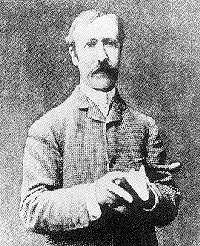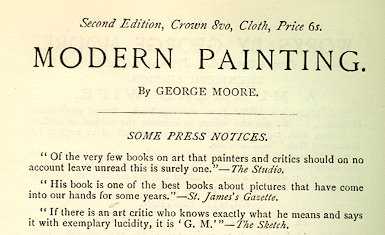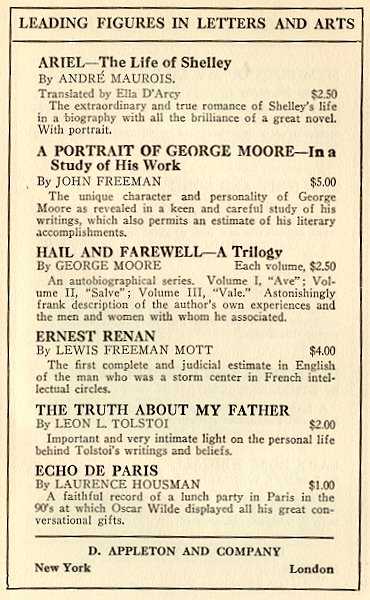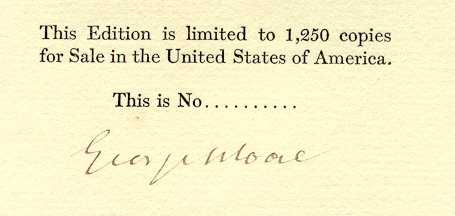
George Moore
1852-1933
Graham Hough
In an infinite number of reviews and comptes rendus of the literature of the world that I have read -- and written -- George Moore is almost invariably forgotten. That is due perhaps to the fact that he belonged to no school in England; perhaps to his want of personal geniality, perhaps to something more subtle."
Ford Madox Ford
I would lay aside the wisest book to talk to a stupid woman.
George Moore, Conversations in Ebury Street (1924)
| BIOGRAPHY |
George Augustus Moore was born on February 24, 1852 to George Henry Moore and Mary Blake Moore of Moore Hall, County Mayo, Ireland. As a boy, he received the private tutoring appropriate to the son of a horse-breeding gentleman and radical Member of Parliament, and in 1861 was sent by his parents to Oscott, a Jesuit school, where, as he noted in Confessions of a Young Man (1888), "it pleased me to read 'Queen Mab' and 'Cain' amid the priests and ignorance of a hateful Roman Catholic college." Moore's father eventually removed him from Oscott at the school's suggestion.
In 1868 George Henry Moore was returned to Parliament after being unseated in 1857, and Moore's family moved to London. In 1870, when Moore was 18, his father died while on business in Ireland, and ownership of the family estate passed into Moore's hands, providing him with a yearly income of between 500 and 4000 pounds per year upon reaching majority. This allowed him, for the rest of his life, to pursue his wide-ranging artistic, literary and philosophical interests.
In 1873, Moore left London for Paris, where he intended to study painting. After enrolling in several studios, first at the Ecole des Beaux Arts and then in several private studios, and making some efforts to master the basics, Moore gave up the notion of becoming a painter, and gave himself over to Parisian cafe society and the conversation of artists and painters. "The creatures whom I met, " he wrote in Confessions of a Young Man (1888), "in the ways and byways of Parisian life, whose gestures and attitudes I devoured with my eyes, and whose souls I hungered to know, awoke in me an intense irresponsible curiosity..."
He indulged that curiosity, picking up quite a bit of deep knowledge of the French schools of painting, poetry, drama and novel-writing before returning to London in 1880 because he had overtaxed his inheritance, which was at the same time being threatened with expropriation by the Irish Land League.
The period 1881 to 1901 marks the first major period of Moore's career. After a few false starts as a writer -- a couple of plays of which few if any copies survive, and two volumes of highly-derivative poetry, in 1883 Moore published A Modern Lover, a scandalous and realistic portrayal of a man's dalliances that was picked up, and then promptly removed, from the two major circulating libraries, Mudies and Smiths, at about the same time that his second realist novel, A Mummer's Wife (1884) was published, detailing in unflinching detail the seduction, elopment and eventual death of a seamstress from the Potteries. The removal of A Modern Lover from the circulating libraries prompted Moore to write Literature at Nurse, or Circulating Morals, a spirited attack on Mudies and Smiths as taste-makers and de facto censors.
He followed these two realist novels and the polemic with a longish essay on Ireland and a novel about the Dublin marriage-market, A Drama in Muslin (1886), and then published in 1888 Confessions of a Young Man, a fictionalized autobiographical account of his days in Paris, and a pioneering work in the at-the-time all-but-undeveloped modernist genre of fictionalized autobiography (c.f. William Hale White).
These in turn were followed by Modern Painting (1893), one of the first analyses of the then-emerging trends in the pictoral arts, and a work that at the time exerted a significant amount of influence on critical perceptions of the "new" schools of painting.

This was followed, in 1894, by Moore's universally acknowledged masterwork, the realist novel Esther Waters. The story of a Plymouth sister who is sent into service, who gets pregnant, has a child out of wedlock, and not only survives the hardships and depredations of single motherhood, but who receives (and declines) multiple offers of marriage and who in the end receives a reward of sorts, Esther Waters was a revolution in both the "outcast woman" genre of major novels that includes Elizabeth Gaskell's Ruth, and a runaway commercial success. It had a special place in Moore's own personal canon as well; it was, he said in Hail and Farewell (1911), the only work of his he ever read after publication, and "not such a bad book as I had imagined it to be when the first copy came to me."
The first period of Moore's artistic life ended with the death of his mother in 1895, and the publication of his novel Evelyn Innes (1898). From his mother's dead until the Irish playwright Edward Martyn (who was Moore's cousin) began to canjole Moore to join the emerging Irish Renaissance movement in 1900, Moore is very quiet, artistically: he spent that time, as he describes in Hail and Farewell, living in London, reading and writing, working on a few plays, and spending evenings with Martyn, Arthur Symons (who was at the time finishing his masterpiece The Symbolist Movement In Literature (1899), and W.B. Yeats.
In 1901, Moore moved to Dublin and began a ten-year period of "Irishness" in which he did little work, but participated in the founding and development of the Irish Renaissance and the Irish politics of the time. His work of that period -- The Untilled Field (1903), The Lake (1905) and Memoirs of My Dead Life (1906) -- are considered to be significant works of, in the former cases, Irish literature, and in the latter case, fictionalized autobiography, but on the whole Moore's work of the second period 1900-1911 is at best incidental to his life.
And that life -- in a sophisticated, elliptical, veyr modernist form -- burst forth during the final period of Moore's life as an artist, beginning in late 1911, when he returns to 121 Ebury Street, London (where he is to live until his death), and publishes the first volume of his fictionalized autobiography Hail and Farewell, called Ave.

Hail and Farewell's publication in three volumes between 1911 and
1914 marks the third and most difficult phase of Moore's career: Moore's
deliberate recasting of himself as the contrarian man-of-letters and scandalous
racounteur. During this period he published very little readable
fiction beyond The Brook Kerith (1916), focusing instead of creating
what I imagine he hoped would be the canonical image of George Moore as
the master of non-fiction prose style and the quintessential man-of-letters
of the early Modernist movement. His novels of the period -- Heloise
and Abelard (1921), Ulick and Soracha (1926) and Aphrodite
in Aulis -- may be excellent examples of Moore's by-now highly refined
prose style, but they are -- like Pater's Marius the Epicurian,
which Moore felt was one of the two or three best novels of the 19th century
-- essentially unreadable today. What marks this period most clearly is
Moore's focus, in Avowals (1919), Conversations in Ebury Street
(1924) on establishing himself as a critic, and his canon-making activities:
the revision of many of his early works, the attachment of prefaces and
other interpretative devices to his novels, and in the creation of the
several limited and collected editions of his work -- privately printed
in expensive formats, signed and numbered -- that occupied Moore from
the early 1920s until his death in 1933.
On his death, Moore's body was cremated and his ashes buried on Castle Island in Lough Carra within sight of Moore Hall.
| CURRENT CANONICAL STATUS |
Moore and Ford Madox Ford were, I sometimes think, one and the same person. Certainly, they damaged themselves in their own lifetimes as badly as was imaginable; they each wrote some of the seminal works of twentieth-century literature; they are both largely extra-canonical today, each contributing a single novel to the canon.
Today, Moore is mentioned, if at all, for Esther Waters, which gets read less often that it gets discussed in print. There is no doubt that Moore's novels between A Modern Lover and Esther Waters constitute the birth of the English realist novel: we are talking after all about a period dominated by novelists like Pearl Craigie (with whom Moore, according to some accounts, attempted an affair), Rhoda Broughton, Marie Corelli, Violet Paget, a deteriorating Wilkie Collins, Conan Doyle, H Rider Haggard, Thomas Hall Caine, and Robert Louis Stevenson: these are the novels and stories circulated by Smiths and Mudies, the decidely anti-realistic mainstream of the English novel at the time. True, Moore was not alone in developing and accelerating the transition to realism. William Hale White was beginning his experiments with fictionalized autobiography at the time; Hardy's major novels are of this period; Kipling's work was beginning to appear; Gissing's early works were published during the same period; Mary Ward and Isreal Zangwill were pursuing their brands of realism, and WT Stead was inventing "realist" sensational journalism. But Moore alone brought the detachment and unstinting observation characteristic of French realism into the English novel: we don't find him (as we find in Gissing) intruding to comment on the rank unfairness of life or (as we find in Kipling and often in Hardy) tilting the moral scales in favor of a perceived political or social good. Moore and Thomas Hardy made the English realist novel a reality, virtually alone, and it was Moore rather than Hardy that made realism a matter of critical and theoretical debate.

But, despite this pride of place, Moore remains a badly neglected figure. Esther Waters was revised substantially at least four times between 1893 and 1931, and yet no one has ever bothered to do a variorum edition or detailed collation of amendations of the texts. All his work except Esther Waters is out of print; even Hail and Farewell, which is a far more human, and frank, look at the Irish Renaissance than those on which we usually rely, is unavailable in modern editions.
Why this is so is a matter of some debate among the people who love Moore, and who periodically leave their day-jobs to write a smallish love-letter on Moore for publication in one of the more obscure academic journals. I deal with my own views of Moore's claims for canonical status elsewhere. This site is dedicated to exploiting the ability of the Web to circumvent the canon-making machinery, and to bringing Moore's texts back to a modern public in critically-defensible forms.
| PRIMARY BIBLIOGRAPHY |
Worldliness: A Comedy in Three Acts. London: Privately-printed, 1874. No copies of this first work exist, and the work may itself be a product of Moore's fictionalizing.
Flowers of Passion. London: Provost, 1878. Poetry.
Martin Luther: A Tragedy in Five Acts. London: Newman, 1881. This play was written for production in London but was never produced.
A Modern Lover. London: Tinsley, 1883.
A Mummer's Wife. London: Vizetelly, 1884. Vizetelly was to be prosecuted for publishing Zola in English. Paperback copies of A Mummer's Wife, published until the early 1960s, can still be found in second-hand bookstores.
An Actor's Wife. Cicago: Laird and Lee, 1890. The American version of A Mummer's Wife.
Literature at Nurse, or Circulating Morals. London: Vizetelly, 1885. One of the great works in the anti-censorship canon.
A Drama in Muslin: A Realistic Novel. London: Vizetelly, 1886. Rewritten and republished as Muslin in 1915.
Parnell and His Island. London: Sonnenschein Lowrey, 1887. Non-fiction prose.
A Mere Accident. London: Vizetelly, 1887. Published simultaneously in the US by Brentano's with the same title.
Confessions of a Young Man. London: Sonneschein Lowrey, 1888. Published simultaneously in the US by Brentano's with the same title. Published by the Modern Library as Volume 16, with an introduction by Floyd Dell.
Spring Days: A Realistic Novel -- A Prelude to Don Juan. London: Vizetelly, 1888.
Mike Fletcher: A Novel. London: Ward and Downey, 1889. Published in America in 1889 by Minerva in New York.
Shifting Love. Chicago: Wilson, 1891. The American version of Spring Days.
Impressions and Opinions. London: Nutt, 1891. Not published in the US until the Brentano's edition of 1913. Non-fiction prose.
Vain Fortune. London: Henry, 1891. Published in America in 1892 by Collier.
Modern Painting. London: Walter Scott, 1893. Published simultaneously by Scribners in the US. Non-fiction prose.
The Strike at Arlingford: A Play in Three Acts. London: Scott, 1893. Published in the US by Scribners. Available today in Eakin and Case. Selected Plays of George Moore and Edward Martyn.
Esther Waters: A Novel. London: Walter Scott, 1894. Published in the US by Stone in Chicago and New York.
The Royal Academy 1895. London: New Budget, 1895. Criticism.
Celibates. London: Walter Scott, 1895. Published simultaneously in the US by Macmillan. Short stories.
Evelyn Innes. London: T Fisher Unwin, 1898. Published in the US by Appleton. Novel.
The Bending of the Bough: A Comedy in Five Acts. London: T Fisher Unwin, 1900. Published in the US by Stone. A rewrite of Edward Martyn's The Tale of a Town.
Sister Theresa. London: T Fisher Unwin, 1901. Published in the US in Philadelphia by Lippincott. Novel.
An T-Ur-Gort. Dublin: Sealy, Bryers and Walker, 1902. The Gaelic version of The Untilled Field
The Untilled Field. London: T Fisher Unwin, 1903. Published in the US in Philadelphia by Lippincott. Short stories.
The Lake. London, Heinemann, 1905. Published in the US by Appleton in 1906. Novel.
Memoirs of My Dead Life. London: Heinemann, 1906. Published in the US by Appleton in 1907. Fictionalized autobiography.
Reminiscences of the Impressionist Painters. Dublin: Maunsel, 1906. Fictionalized autobiography and criticism.
The Apostle: A Drama in Three Acts. Dublin: Maunsel, 1911. Published in the US in Boston by Luce the same year.
Hail and Farewell: A Trilogy. London: Heinemann, 1911-1914. Published in the US by Appleton. Volumes were, in order, Ave, Salve, Vale. Fictionalized autobiography.
Elizabeth Cooper: A Comedy in Three Acts. Dublin: Maunsel, 1913. Published in the US in Boston by Luce. Outcome of an abortive collaboration with Pearl Craigie.
Esther Waters: A Play in Five Acts. London: Heinemann, 1913. Published in the US in Boston by Luce. Two other versions of this play, produced in 1911, are available today in Davis. The Celebrated Case of Esther Waters. One is Moore's; the other is Barrett Clark's.
Muslin. London: Heinemann, 1915. Published in New York by Brentano's. A revision of A Drama in Muslin.
The Brook Kerith: A Syrian Story. Edinburgh: T Werner Laurie, 1916. Published in the US by Macmillan. Novel.
Lewis Seymour and Some Women. London: Heinemann, 1917. Published in the US by Brentano's. A revision of A Modern Lover.
A Story-Teller's Holiday. London: Cumann Sean-eolias na h-Eirann, 1919. Fictionalized autobiography. A privately printed edition. Revised and reprinted in a trade edition in 1928 by Heinemann.
Avowals. London: Cumann Sean-eolias na h-Eirann, 1919. Criticism. A privately printed edition. Reprinted in a trade edition in the US by Brentano's the same year.
The Coming of Gabrielle: A Comedy. London: Cumann Sean-eolias na h-Eirann, 1920. Play based on Moore's real-life correspondence with an anonymous Austrian noblewoman.
Heloise and Abelard. London: Cumann Sean-eolias na h-Eirann, 1921. Published in the US by Boni and Liveright.
In Single Strictness. London: Heinemann, 1922. Published in New York by Boni & Liveright. Short stories.
The Apostle: A Drama in a Prelude and Three Acts, London: Heinemann, 1923. A revision of the earlier version.
Conversations in Ebury Street. London: Heinemann, 1924. Published in the US by Boni & Liveright. Criticism.
Peronnik the Fool. New York: Boni & Liveright, 1924. One of only three books of Moore's to appear first in the US. Published in the US by Heinemann in 1933. Fiction.
Pure Poetry: An Anthology. London: Nonesuch, 1924. Published in the US by Boni & Liveright. Anthology of poetry. Available today from Liveright with an introduction by Malcolm Cowley.
The Pastoral Loves of Daphnis and Chloe Done In English. London: Heinemann, 1924. Moore's translation of Amyot's 1559 French translation of Longus' work.
Ulich and Soracha. London: Nonesuch, 1926. Published in the US by Boni & Liveright. Novel.
The Making of an Immortal: A Play in One Act. New York: Bowling Green Press, 1927.
Celibate Lives. London: Heinemann, 1927. Published in the US by Boni and Liveright. A revision of In Single Strictness.
A Flood. New York: harbor Press, 1930. Novel.
Aphrodite in Aulis. London: Heinemann, 1930. Published in the US in New York by the Fountain Press. Novel.
The Passing of the Essenes: A Drama In Three Acts. London: Heinemann, 1930. Published in the US by Macmillan. A further revision of The Apostle.
The Talking Pine. Paris: Hours Press, 1931.
A Communication to My Friends. London: Nonesuch, 1933.
Collected Editions The Collected Works Of George Moore. Carra Edition. 21 Volumes. New York: Boni & Liveright, 1924. A limited edition.
Works of George Moore. Uniform Edition. 20 volumes. London: Heinemann, 1924-1933. New York: Brentano's: 1924-33. This edition included: A Mummer's Wife, Muslin, Confessions of a Young Man, Esther Waters, The Untilled Field, The Lake, Memoirs of My Dead Life, Hail and Farewell, The Brook Merith, A Story-Teller's Holiday, Heloise and Abelard, Celibate Lives, Avowals, Aphrodite in Aulis, The Passing of the Essenes, Conversations in Ebury Street, Peronnik the Fool and The Pastoral Loves of Daphnis and Chloe.
| SECONDARY BIBLIOGRAPHY |
Major Works
Edwin Gilcher. A Bibliography of George Moore. Dekalb, Illinois: Northern Illinois University Press, 1970.
Joseph Hone. The Life of George Moore. London: Gollancz, 1936.
John Eglinton, ed. Letters of George Moore to Edward Dujardin. New York: Gaige: 1929.
Rupert Hart-Davis, ed. George Moore: Letters to Nancy Cunard 1895-1933. London: Hart-Davis, 1957/
Helut Gerber. George Moore in Transition: Letters to T. Fisher Unwin and Lena Milman 1894-1910. Detroit: Wayne State University Press, 1968.
Douglas Hughes, ed. The Man of Wax: Critical Essays on George Moore. New York: New York University Press, 1971.
Other Works
Malcolm Brown, Ceorge Moore: a Reconsideration (Seattle: University of Washington Press; 1955)
Brown, E. K. Rhythm in the Novel. Brown, Malcolm. George Moore: Seattle, 1955. Clark, Barrett H. Intimate Portraits. New York, 1951.
Christophe Campos, The View of France from Arnold to Bloomsbury (Oxford: Oxford University Press; 1965)
Richard A. Cave, A Study of the Novels of George Moore (Gerrards Cross: Colin Smythe; 1978) (Irish Literary Studies, no. 3)
George P. Collet, George Moore et la France (Paris and Geneva: E. Droz; 1957)
Cunard, Nancy. G.M.: Mernories of George Moore. London, 1956.
Cooper, Douglas. "George Moore and Modern Art," Horizon, XIV (February, 1945), 1l3-b.30.
Decker, Clarence R. The Victorian Conscience. New York, 1952.
Janet E. Dunleavy, George Moore: the Artist‘s vision, the Storyteller’s Art (Lewisburg: Bucknell University Press; 1973)
Eglinton, John. Irish Literary Portraits. London, 1935.
Ervine, St. John. Some Impressions of My Elders. New York, 1922.
Ferguson, Walter. The Influence of Flaubert on George Moore. Philadelphia, 1934. (Reissued 1969)
Flower, Robin. The Irish Tradition. Oxford, 1947.
Freeman, John. A Portrait of George Moore in a Study of His Work. London, 1922.
Frierson, William C. The English Novel in Transition. Norman, Oklahoma, 1942.
William C. Frierson, ‘George Moore Compromised with the Victorians’, Trolloptan I (March 1947), pp. 37-44
Goodwin, Geraint. Conversations with George Moore. London, 1929.
Graham, Kenneth. English Criticism of the Novel, I864I 900. Oxford, 1965.
Gwynn, Denis. Edward Martyn and the Irish Revival. London, 1930.
Helmut E. Gerber, CeorgeMoore in Transition (Detroit: Wayne State University Press; 1968)
Royal A. Gettmann, ‘George Moore’s Revisions of The Lake, The Wild Goose, and Esther Waters’, YMLA 59 dune 1944), pp s40-ss
Elliott L. Gilbert, ‘In the Flesh: Esther Waters and the Passion for Yes’, Novel IX (Fall 1978), pp. 48-65
Granville Hicks, ‘The Miracle of Esther Waters’, in his Figures in Transition: a Study of British Literature at the End of the Nineteenth Century (New York: Macmillan; 1939)
Graham Hough, ‘George Moore and the Novel’ and ‘Moore and the Nineties’, in his Image and Experience: Studies in a Literary Revolution (London: Duckworth; 1960)
Howarth, Herbert. The Irish Writers, I880-I940. New York, 1959.
Huneker, James. The Pathos of Distance. New York, 1913.
Jackson, Holbrook. She Eighteen-Nineties. New York, 1922.
Jeffares, A. Norman. George Moore. London, 1965.
Lyons, F. S. L. " George Moore and Edward Martyn," Hermathena, XCVIII ( l 964), 9-32.
Katherine Mansfield, ‘Esther Waters Revisited’, in her Novels and Novelists (London: Constable; 1930)
Mitchell, Susan I,. George Moore. New York, 1916.
Morgan, Charles. An Epitaph on George Moore. New York, 1935
Nejdefors-Frisk, Sonja. George Moore’s Naturalistic Prose. Ipsala, Sweden, 1952.
Jean C. Noel, George Moore: I’homme et l’oeuvre (1852-1933) (Paris: Didier; 1966) (Etudes anglaises no. 24)
O’Connor, Frank. A Short History of Irish Literature. New York, 1967.
Graham Owens (ed), George Moore’s Mind and Art (Edinburgh: Oliver and Boyd; 1968)
Phelps, Gilbert. The Russian Novel in English Fiction. London, 1956.
Phelps, W. L. Autobiography with Letters. New York,1939.
Enid Starkie, From Gautier to Eliot: the Influence of France on English Literature 1851-1939 (London: Hutchinson; 1960)
Virginia Woolf, 'George Moore’, in her The Death of the Moth (London: Hogarth Press; 1942)
Roberts, R. Ellis. "George Moore," Nineteenth Century, CXIII (March, 1933), 369-83.
Sechler, Robert P. George Moore: A Disciple of Walter Pates. Philadelphia, 1931. (Reissued 1969)
Steward, S. M. "Huysmans and George Moore," Romanic Review, XXV (July-September, 1934), 197-206.
Taylor, Estella Ruth. The Modern Irish Writers. Lawrence, Kansas, 1954. (Reissued 1969, New York)
Temple, Ruth Zabriskie. The Critic’s Alchemy. New York, 1953.
Wolfe, Humbert. George Moore. New York, 1932.
Last updated 11-25-06 by Marc Demarest (marc@noumenal.com)